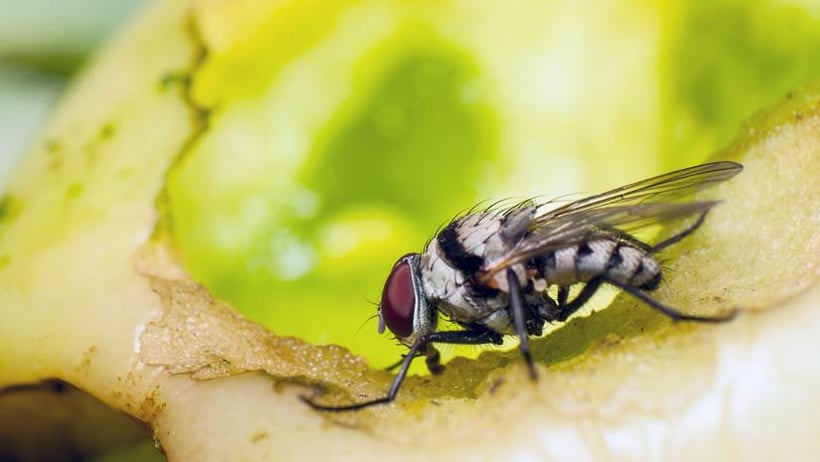
Anyone who has encountered swarms of flies in their workplace knows all too well how much of a problem these insects can present — especially if their business prepares, sells, or serves food!
Not only can flies easily find their way inside, but they also reproduce very quickly and present a health and safety issue by contaminating every surface they land on.
From the customer's perspective, flies are irritating and known to be filthy, all of which is bad news for any establishment that sells food.
Flies can be a big deal
Flies may be small, but they are damaging in significant ways. Flies can:
- Spread disease: Flies transfer pathogenic microorganisms, including bacteria that make people sick, simply by landing on food contact or preparation surfaces. Their bodies, eggs, faeces and vomit all play a part in flies’ ability to transfer more than 100 pathogens including E. coli, Salmonella and Shigella. Many of these diseases involve symptoms such as vomiting, stomach cramps, diarrhea, fever and dysentery.
- Contaminate food: When flies land on food, they immediately vomit on it — this allows them to dissolve and slurp up food, as they can’t chew. Flies’ stomachs contain anything from garbage to feces, germs, rotting meat and decayed organic matter, leading to food poisoning for your customers.
- Breed rapidly: A female housefly can produce 1,000 eggs in her roughly 28-day lifetime. It only takes 10 days for larvae to mature into adults. In short, flies reproduce at a rate that can become uncontrollable for a business.
- Hurt your reputation and bottom line: If you have flies in your establishment, you won’t have customers for long — no one wants to constantly swat pests away from themselves and their meal. Flies can damage your reputation, and cost money in lost revenue as well as fees associated with failed health inspections.
Identify any issues
You can likely identify an existing fly problem simply by seeing the insects buzzing around. However, you may also be able to predict an upcoming issue if you or an employee spot a cluster of larvae or eggs, which can be seen with the naked eye.
What do fly eggs and larvae look like?
- Housefly larvae (maggots) resemble small, white or pale worms
- Housefly eggs look like grains of white rice
- Housefly pupae are dark in colour with hard outer shells
Prevent flies’ entry with a few best practices
Flies are attracted to food, sugars in alcohol, garbage, scraps and to any area that promises a meal! Make your establishment unwelcoming to flies by following a few simple guidelines:
- Never leave waste or unused food lying around your business
- Keep dumpsters as far from the building as possible, and ensure you use leak-proof and pest-proof garbage containers
- Regularly clean and sanitize garbage containers and recycling bins
- Clean up food spills as soon as they happen
- Clean food contact equipment at least once per day
- Keep doors, windows and any other openings sealed shut
- Ensure alcohol containers are sealed; if alcohol bottles have spouts, cover them tightly with plastic when not in use
Your establishment is probably already following these rules, as they’re just good business practices. Boost your cleaning and sanitizing practices to keep flies and other pests away, and prevent food-borne illness.
Already have flies? Tackle the problem head-on
The three main tools used for getting rid of a fly infestation include:
- Fly spray: While effective for killing flies, sprays can easily cause chemical contamination of food if they’re used near open food or food preparation surfaces. This means you must only use fly sprays when the whole area is not in use (e.g. after closing) and move all utensils, equipment or food out of the way first. After spraying, clean and sanitize any equipment in the vicinity.
- Electrocutors: These attract flies, moths and other insects to the inside of the unit, and kill them with high-voltage electricity. The unit can’t hold many insects, though, so dead flies will often fall to the ground below. This makes it imperative to place electrocutors at least two metres from food preparation or storage areas, and empty them frequently.
- Fly strips: These attract flies to sticky paper that traps them, which you can then throw away. Replace fly strips frequently, and wash your hands thoroughly after handling them.
At the Canadian Institute of Food Safety (CIFS), we provide CIFS Members with a library stocked full of useful food safety resources, such as the CIFS Guide to Pest Prevention and Control, which explains ways to eradicate flies and other pests that present problems for a food business. Contact us to find out more about membership, or to enrol in the Official CIFS Food Handler Certification Course.





